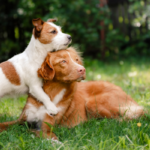Is your pet joining you for a Christmas holiday trip? Follow these basic pet travel guidelines to keep everyone merry!
Making a list and checking it twice
- Pets away from home can easily get disoriented and lost. Before you travel, check that your pet’s microchip registration details are up-to-date. If you are unsure, log onto your state pet registry website or contact your local council. It’s safest to make sure your pet is also wearing an ID tag or collar marked with your best contact number.
- Think about everything your pet will need for the trip. This often includes a secure carrier or collar/harness and lead, plus bowls, your pet’s regular food, some familiar comfortable bedding and a few “keep busy” toys or treats. If you’re bringing your cat, don’t forget to pack cat litter and a tray. For dogs, bring a decent supply of poo bags.
- If you know your pet gets sick or stressed on car journeys, please contact us to discuss the safest options for relief medications. Mildly anxious pets may benefit from starting the calming natural supplement Zylkene several days prior to travel.
- At least 48 hours prior, ensure that you have sufficient supply of any regular medication your pet takes and that they’re up-to-date with tick and flea prevention.
- If you’re travelling to the east coast of Australia, bring a “Tick Twister” – a device for easily removing ticks from your pet. If you don’t know how to monitor your pet for ticks, please phone us to ask for advice.
For the sleigh ride
- Encourage your pet to go to the toilet before starting your journey, so they’re more likely to rest comfortably. It’s best to avoid giving your cat or dog a large meal for several hours prior to travel to reduce the potential for car-sickness.
- 15 minutes prior to travel, apply a calming pheromone spray onto your pet’s travel bedding. For pheromone sprays, use: Adaptil for dogs and Feliway for cats. This can help them to feel secure during the upheaval of their normal environment and routine.
- For everyone’s safety, ensure your pet is properly secured in the car. For most dogs, the safest option is usually restraint on the back seat using a safety-tested car harness and seatbelt attachment system. For cats or small dogs, it’s best to use a properly-secured travel crate. Check that the crate is large enough for your pet to stand up and lie down in comfortably, and has good airflow to prevent overheating.
- Every two hours, stop to offer your pet some water and take dogs for a toileting walk. For long trips with a cat, it’s best to plan in advance for toileting stops at least every four hours, somewhere that you can set up a litter tray for them in a safe, confined area. Cats in unfamiliar environments may be too worried to pass urine for up to twelve hours, but it’s best to offer opportunities all the same.
If you have any concerns about taking your pet on holiday, please don’t hesitate to phone our friendly team for advice.






